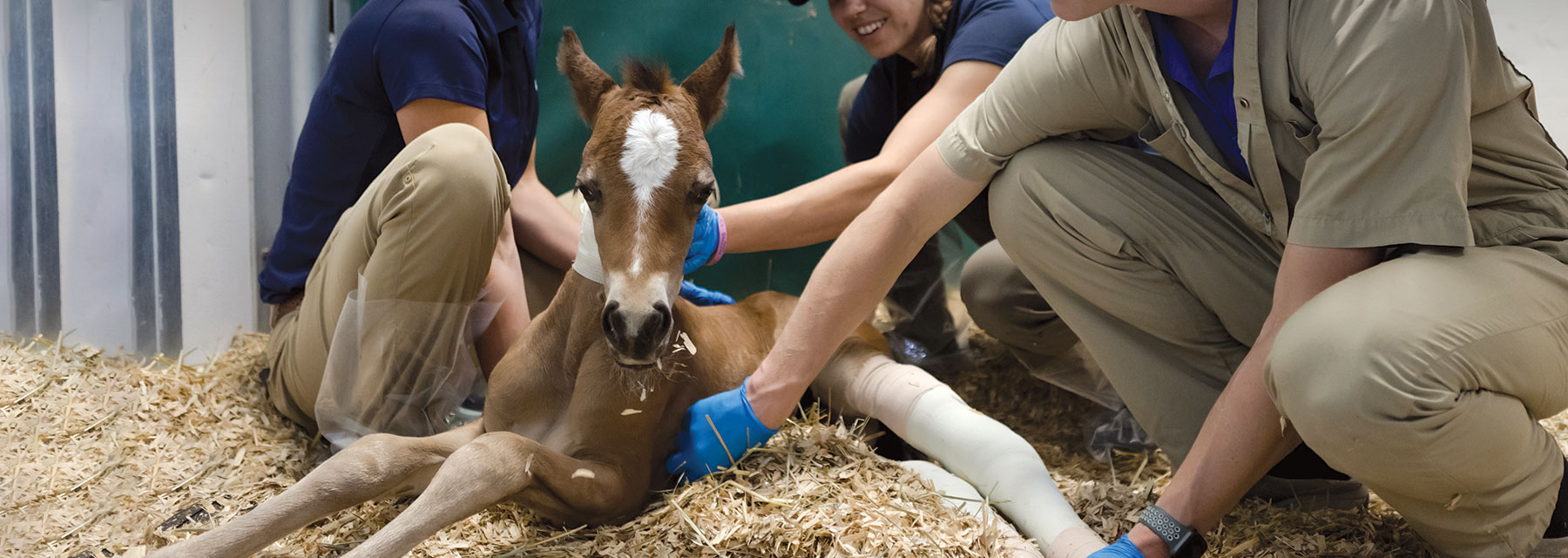Contracted Tendons in a Foal Can Be Treated With Early Detection and Meticulous Management
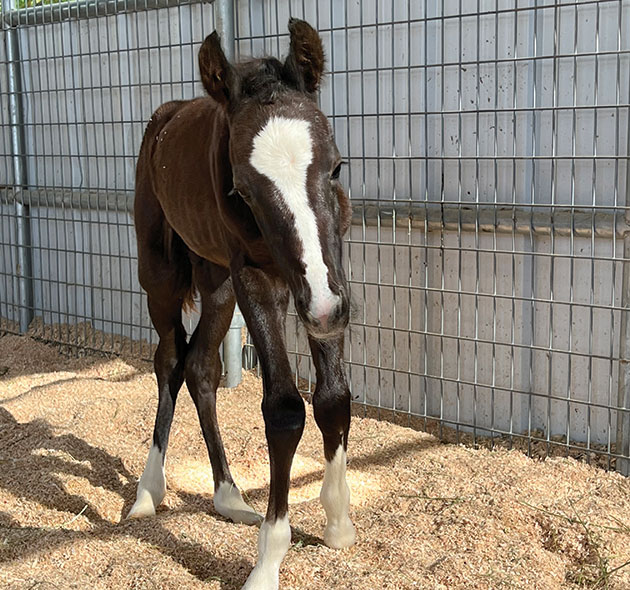
COURTESY PHOTO
Forrest Gump, at less than 12 hours old, has flexural limb deformities, or contracted tendons, along with some other issues.
Breeding horses is not for the faint of heart. It is like being on a roller coaster with your veterinarian — a ride that lasts an entire year while your mare conceives and carries the foal. Only the ride doesn’t end there, you just get on a bumpier one after that. I learned this the hard way breeding my 16-year-old heart horse to a prominent stallion. After patiently waiting about 250 days — 90 days from her due date — my mare started dripping milk. I immediately rushed her to the vet. Holding back tears and fearing the worst, the ultrasound came back with a healthy heartbeat from the foal. This was good news, but there was more work ahead to save the baby while keeping my broodmare healthy. The diagnosis was placentitis, a fairly-common infection of the placenta and, when detected early, can be successfully treated. For the next three months, I administered medication to my mare twice a day and monitored her every move hoping to keep that baby inside until its due date. When we had finally made it, I thought my worries were behind me, but more challenges loomed ahead. After my mare finally gave birth, her newborn stud colt, with all his chrome, had difficulty standing. He was unusually weak, even for a foal, and his spindly legs were all going different directions. I was in shock. After investing a lot of time and money into making the perfect cross, the end result wasn’t what I had imagined. How would this baby with crooked legs, who I had formed an attachment to even before he was born, ever become the performance horse I first dreamed of?
The initial trauma of seeing my foal trying to hobble around soon wore off, and we named him Forrest Gump in hopes that, like the film character, he would also overcome his crooked legs. I later learned that he suffered from a multitude of issues, including flexural limb deformities, or contracted tendons. Although this is a common and treatable condition in newborn foals, I felt as though I had just entered the pinwheel of the roller coaster ride.
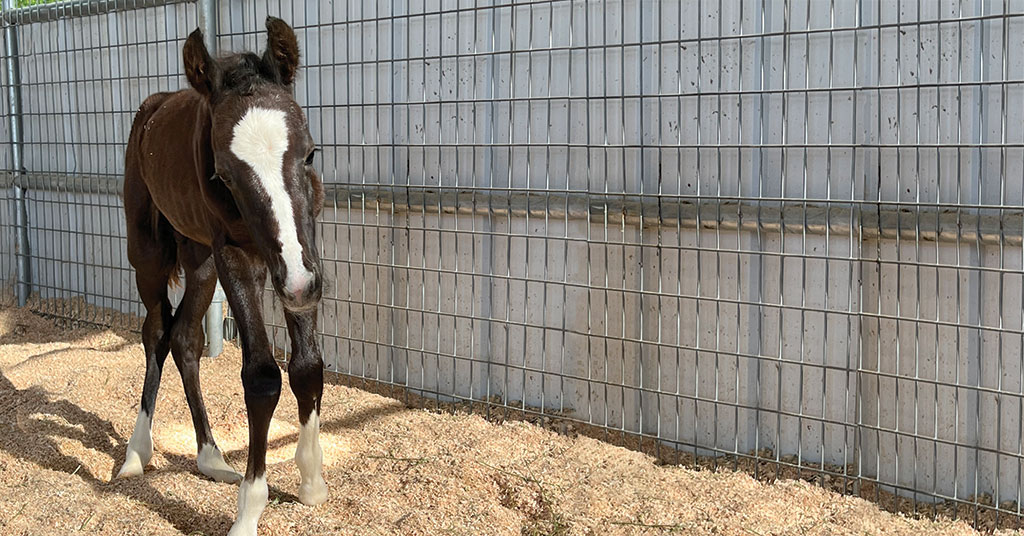
COURTESY PHOTO
Forrest Gump, at less than 12 hours old, has flexural limb deformities, or contracted tendons, along with some other issues.
“Flexural limb deformities are in a front-to-back plane while angular limb deformities are in a side-to-side plane. Even though they can all be present together and there are some commonalities among them, it’s important that we manage them differently.”
— Phoebe Smith, DVM, DACVIM, Riviera Equine Internal Medicine and Consulting
Gaining A Better Understanding
To better understand bone and tendon health in newborn foals, Phoebe Smith, DVM, DACVIM of Riviera Equine Internal Medicine and Consulting in Santa Ynez, California, lends her knowledge and hands-on experience. Dr. Smith is a longtime friend and colleague to Platinum Performance®, starting her career as a veterinary intern in the late 1990s at Alamo Pintado Equine Medical Center in Los Olivos, California, where Platinum was founded. She was also involved in some of the innovative research behind one of Platinum’s leading formulas: Bio-Sponge®. After becoming a board-certified specialist in equine internal medicine, she served as an internist at Alamo Pintado and as an assistant professor at The Ohio State University. Blending real world and academic experiences, Dr. Smith returned to California and opened her own practice where she accepts referrals for complicated internal medicine cases and assists larger local farms with their breeding operations. She is an expert in her field working as an internist in the ambulatory setting and serving on several committees with prominent veterinary associations, including the American Association of Equine Practitioners (AAEP) and American College of Veterinary Internal Medicine (ACVIM).
There are two types of front limb deformities that can be seen in foals: flexural and angular. These are characterized by which direction the legs appear to lean. “Flexural limb deformities are in a front-to-back plane while angular limb deformities are in a side-to-side plane,” Dr. Smith explains. “Even though they can all be present together and there are some commonalities among them, it’s important that we manage them differently.” The more common type of flexural deformity is known as contracted tendons, but overly lax tendons are also seen, both of which were seen in Forrest's case. “It’s what we’ve always called them, but it’s really that the bone to tendon length is not quite right,” she says. “For whatever reason, a tendon didn’t elongate quite enough or in proportion to the bone, so the bone is a little bit longer than the tendon.” In most cases, this will cause the toe to curl up under the foot and the foal to stand abnormally upright, although the opposite is also possible, where the tendons are overly loose. Mild cases of contracted tendons typically resolve without complications, but without early intervention, some foals can develop a club foot where the angle of the foot is overly steep. Once into adulthood, this becomes a permanent conformation.
On the contrary, angular limb deformities occur when the development within the bone’s growth plate near the level of a joint isn’t symmetrical. This causes the joint to deviate either to the outside, such as in a “knock-kneed” foal (carpal valgus), or to the inside such as a toed-in conformation (fetlock varus). As with flexural deformities, many angular limb deformities resolve without complications, but in advanced cases, intervention is necessary.
Foals can have front limb abnormalities for a multitude of reasons. While some can be acquired over time, others are congenital, meaning the foal is born with the deformity. One of the most common causes of contracted tendons is malpositioning in the uterus where the legs of the fetus aren’t able to stretch out to elongate the tendons. Other cases include foals with rapid weight gain, poor nutritional management with increased protein or unbalanced minerals and those struggling from other conditions. “Sometimes we see it in foals that are really growthy,” Dr. Smith explains. “They just grow so quickly that the bones grow faster than the tendons. Others will develop contracted tendons if they have had an illness or injury, and they haven’t gotten any sort of normal exercise.” Similar to contracted tendons, angular limb deformities can also be caused by nutritional imbalances, infections (including placentitis) and exercise. However, genetic predisposition and trauma are the most common causes.
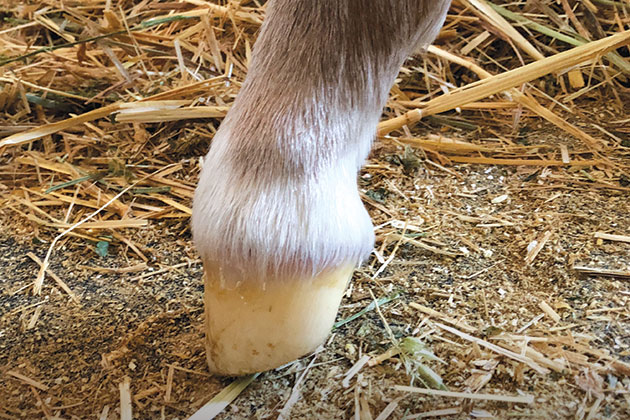
COURTESY PHOTO
The classic stance of a contracted tendon where the toe is curled up under the foot and the foal stands abnormally upright.
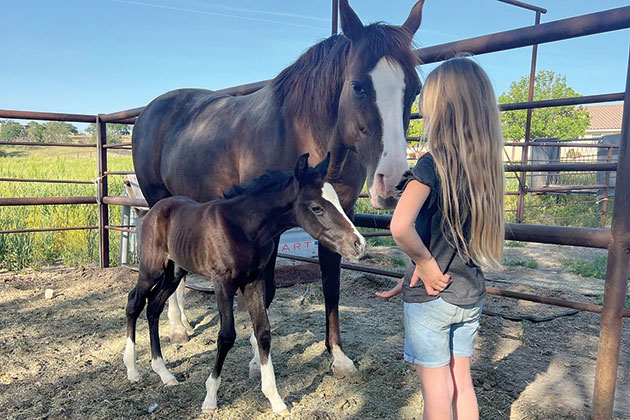
COURTESY PHOTO
Forrest is already looking better at 1 week old.
Nutrition
While the specific cause of contracted tendons remains unknown, the health of the foal relies on the nutritional status of the broodmare. “I think the causes of contracted tendons are multi-factorial,” Dr. Smith says. “I suspect there’s some genetic predisposition to them, but I also think that in-utero conditions and nutrition play a role too.” All horses thrive on high-quality forage as the bulk of their diet. Although pasture grass is preferred because of its high fiber, natural vitamin E and the ideal ratio of omega-3 to omega- 6 fatty acids; a good quality hay, less than a year old and fed free choice, is an excellent alternative. A comprehensive vitamin and mineral supplement will ensure any nutritional dietary gaps are met. A common mistake when feeding a mare in foal is to overfeed grains or concentrates (calories) and underfeed vitamins and minerals, when the opposite is needed. If extra calories are needed to maintain body condition, provide a fortified feed designed for broodmares to avoid overfeeding unwanted nutrients.
Once on the ground, foals may nibble on Platinum Performance® Equine with their mother. It will provide a high level of omega- 3 fatty acids, vitamins, minerals and amino acids to support healthy growth and development. Other support formulas to consider adding to the wellness formula include:
- Osteon®: This formula provides a natural source of silicon that is helpful in supporting strong and healthy bones, tendons and ligaments. Although foals don’t eat much in the first few weeks of life, it doesn’t hurt to give this to the mare and foal, so that the baby is at least getting a little bit of bone and tendon support.
- Platinum Balance™: Because many of the treatment options for contracted tendons can be stressful on the foal, providing a daily probiotic and prebiotic blend like Platinum Balance™ can help support digestive health.
- Platinum Gastric Support: Recommended for foals experiencing stress to support hindgut health, Platinum Gastric Support helps maintain healthy gastric acid levels in the stomach. This digestive support formula should be considered for foals when faced with traumatic experiences like corrective trimming or surgery.
- Bio-Sponge®: This formula can be used with antibiotics, such as oxytetracycline, to help support healthy gastrointestinal function in foals.
Treating Contracted Tendons
Even though appearances can be shocking, the most important thing to remember with flexural limb deformities is not to panic. “It’s remarkable the changes that happen in the first 48 hours. The foals sort of unfold and stretch on their own,” Dr. Smith says. Depending on the level of severity present, the prognosis can generally be positive with the help of a veterinarian.
Stall Rest
For mild cases where a foal is upright, but the heel isn’t quite down yet, Dr. Smith recommends letting their natural weight stretch the tendons. “I will give them two or three days and then come back to recheck and see,” she says. During this time, she prefers keeping the mare and foal in a smaller controlled space as too much exercise can cause the foal’s condition to worsen.
Bandaging
For foals that need intervention because they are buckling over the front and can’t stand properly, Dr. Smith begins with bandaging the affected limb to help it align and stretch. “I use a pretty robust cotton bandage to start with,” she says. “I think it’s important that the type of bandage and the distribution of tension across the limb be pretty specific, which is why it’s best done by a veterinarian.” In more severe cases that require additional support, Dr. Smith will move to a splint. “Splints are really handy to use to make a much stiffer bandage that can be applied very carefully,” she says. The downfall is splints have to be removed and redone every eight to 12 hours, which is why some veterinarians prefer casts. “I personally like bandages with splints because I can micromanage them,” she says. “I’ll apply it in such a way that the client can take it off at a certain time and then I’ll be back the next morning to put it back on. That way I have the ability to see how things are progressing.” Because foals have very thin and sensitive skin, pressure sores and scarring are a huge risk, which makes it pertinent that any form of support is applied correctly. Luckily, there are many types of commercial splints and casts that can be used to make the process easier. “I’ve used them all, and it really depends on what’s going on with the foal and the severity of the flexural deformity as to which one I’ll reach for,” Dr. Smith concludes.
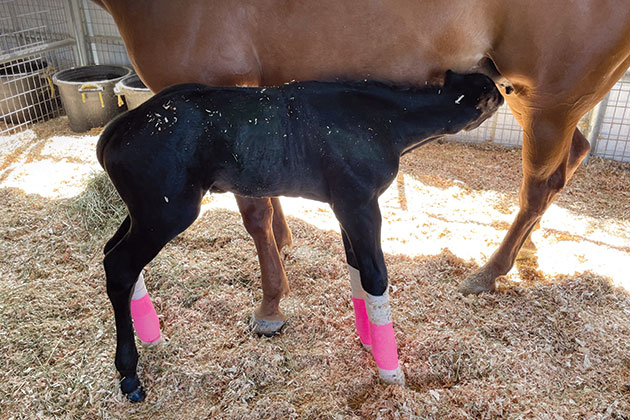
For foals that need intervention because they are buckling over the front and can’t stand properly Dr. Phoebe Smith begins with bandaging the affected limb to help it align and stretch. In more severe cases that require additional support, Dr. Smith will move to a splint.
For foals that need intervention because they are buckling over the front and can’t stand properly, Dr. Phoebe Smith begins with bandaging the affected limb to help it align and stretch. In more severe cases that require additional support, Dr. Smith will move to a splint.
“I think it’s important that the type of bandage and the distribution of tension across the limb be pretty specific, which is why it’s best done by a veterinarian.”
— Phoebe Smith, DVM, DACVIM, Riviera Equine Internal Medicine and Consulting
Oxytetracycline
The administration of oxytetracycline, a broad-spectrum antibiotic, has been shown to relax a foal’s tendons and help with flexural limb deformities. Although the exact reason why is unknown, the antibiotic has been proven effective if given in high doses within the first 72 hours of life. “It’s sort of an oldie but goodie that is used,” Dr. Smith says. “There are theories about how it works, but they just haven’t been proven, so we don’t really know why it helps, but it does.” The main risk is that it is an intravenous injection given in a very high dose that can cause renal failure. Cautions the internist: “It’s not a standard dose, so you can only give it in 24- to 48-hour intervals a couple of times and a potential complication is kidney damage.” Dr. Smith recommends closely monitoring kidney values and combining the antibiotic with IV fluids to help the kidneys function properly.
Non-Steroidal Anti-inflammatories
Because foals may experience pain in trying to stretch out their tendons, administering a non-steroidal anti-inflammatory medication may be appropriate. “It doesn’t help these foals to move normally and stretch when they are in pain,” Dr. Smith explains. “They’re going to be guarded and not want to move around.” She warns that foals are exquisitely sensitive to these types of drugs, adding: “You have to be super conscientious because nonsteroidals can be taxing on their kidneys and their GI tract. It’s all doable. It’s just all the pieces that go into how to manage a flexural limb deformity.”
Exercise
Depending on the severity of the case, exercise can help ease contracted tendons. For foals unable to walk or are wrapped in a heavy bandage or splint, Dr. Smith doesn’t recommend exercise until they are weight bearing. “It’s a lot of work for these foals when they’re wearing a heavy bandage,” she says. “They can’t bend, and they get frustrated. So I try to make their life a little bit easy until we can get to that point.” Once they are able to comfortably walk around, then exercise becomes more like physical therapy. Not only is the amount of exercise important but also the type of surface the foal is turned out on affects how the tendons stretch. “I don’t want them standing at awkward angles,” she says. “I want them on nice solid, flat footing. Not deep sand — and no slopes either.” A related challenge is to keep the broodmare under control. “I don’t like to turn the mare and foal out for an hour because usually the mare runs like crazy because she’s been cooped up, and then the foal tries to follow her. So that’s not controlled exercise.” Dr. Smith prefers hand walking the mare and letting the baby follow to better control the activity level.
Corrective Trimming
Although hoof trimming can help with angular limb deformities, it’s not as useful for foals with contracted tendons. Dr. Smith explains: “Ideally, we’re addressing flexural limb deformities in the first couple of weeks of life versus the angular limb deformities, where trimming is done later on and can be the key to medical management.” Because newborns haven’t had a chance for their hooves to grow out, there’s not much that a shoer can trim to make a difference for the deformity. If conditions persist, and the foal needs surgery, therapeutic trimming can be a part of the recovery. “At that point, we can try to lower the heel on the contracted limb to slowly stretch it a little bit more,” she concludes.
Surgery
Surgery, Dr. Smith adds, should only be used as a last resort, after all other treatment methods have been considered and tried. “Surgery is designed for those foals that have not responded to anything we have tried for at least two or three weeks,” she adds. That’s when it might be worth consulting a surgeon to see if surgery is necessary.” The type of procedure will depend on where the tendon is contracted, although one of the most common surgeries is the check ligament desmotomy, which is generally performed when the foal is 3 to 6 months old. This approach cuts the check ligament, which in turn lengthens the deep digital flexor tendon and allows the toe to stretch out. Although these surgeries tend to have a high success rate, Dr. Smith prefers exhausting all other options first due to risks associated with anesthesia and recovering carefully.
Exiting The Roller Coaster
Luckily for Forrest and me, we were in the hands of a great veterinarian, Dr. Melissa Patten of River Grove Vet Services in Paso Robles, California. She was there from the beginning, overseeing and assisting in his birth. Due to contracted tendons, his crooked legs got stuck in the birth canal. Once he was safely on the ground, it took him about 30 minutes to properly stand and drink. The next day — not even 24 hours later — Dr. Patten splinted his front legs to begin the straightening process. After just 12 hours with his splints on, Forrest’s legs straightened enough to come home. For the next two months, he was kept in a confined pen and left to grow and strengthen on his own. It soon became evident that his tendons were not going to be an issue; however, he did have surgery on his front left leg because an angular limb deformity didn’t correct on its own. It is important to note that Forrest was not a good candidate for oxytetracycline because he was suffering from lax tendons in the hind end, and that antibiotic would have relaxed them even further. Because of the thoughtful and attentive care provided, we are looking forward to Forrest’s performance career in the coming years.
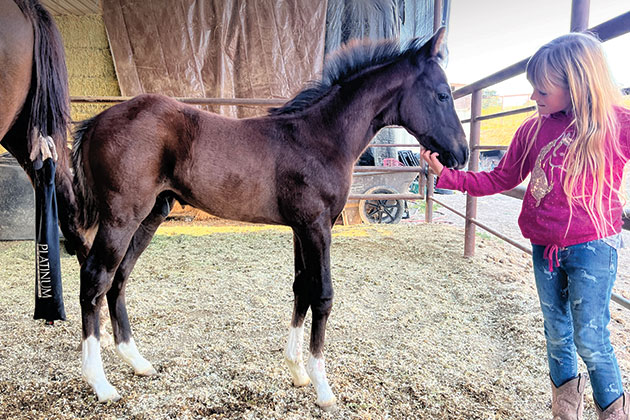
At 6 weeks old, Forrest Gump’s legs have significantly improved.
At 6 weeks old, Forrest Gump’s legs have significantly improved.
Update on Forrest
Within two weeks of Forrest Gump’s birth, he was a different foal: stronger, straighter and full of life. Although he struggled with more than just contracted tendons, he overcame his crooked legs. He will begin training to become a performance horse next spring!
Feeding Protocol for Forrest and His Mother:
4 scoops of Platinum Performance® Equine, 2 scoops of Osteon® and 2 scoops of Platinum Balance™ once daily.
A Bright Future
Just like in Forrest Gump’s case, a diagnosis of contracted tendons doesn’t have to be a lifelong problem. These abnormalities can improve if recognized early and treated carefully. Dr. Smith says: “The one thing I would say is to be patient with these flexural limb deformities. Most can be resolved with management, I think that’s important to know.” She also highlights the importance of providing detailed care. “The other piece to be aware of is sometimes these foals will respond dramatically, so I think frequent veterinary visits should be expected,” she says.
Her experience has shown that in just 48 hours, a foal’s limbs can often overcorrect in the opposite direction proving that micromanagement is the only path to a successful outcome. “They’re not machines, so I think just expecting that is the only way to treat these foals,” she concludes.
